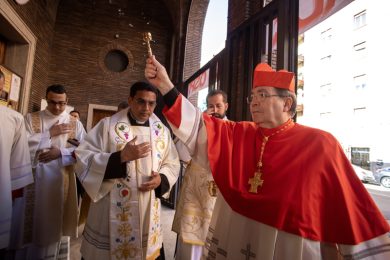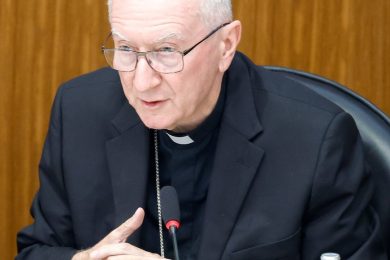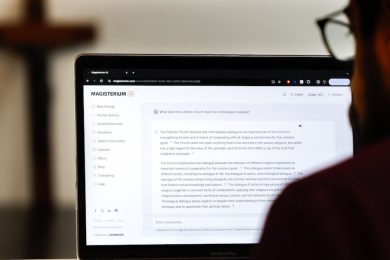By Rita A. Thiron
On the night before he died, Jesus gathered with his disciples to celebrate a Jewish Passover meal. Repeating ancient rituals over simple bread and wine — gifts of the Creator and work of human hands — he gave thanks over them, broke the bread, and gave the bread and the cup to his followers.
Brothers and sisters: I received from the Lord what I also handed on to you, that the Lord Jesus, on the night he was handed over, took bread, and, after he had given thanks, broke it and said, “This is my body that is for you. Do this in memory of me.” In the same way also the cup, after supper, saying, “This cup is the new covenant in my blood. Do this as often as you drink it, in remembrance of me” (1 Corinthians 11:23-26).
[perfectpullquote align=”right” bordertop=”false” cite=”” link=”” color=”” class=”” size=”14″] Note: June 19 is The Solemnity of the Most Holy Body and Blood of Christ. [/perfectpullquote]When Jesus instituted the Eucharist, he gave a new and definitive meaning to the blessing of the bread and the cup (Catechism of the Catholic Church 1334). Because it is a memorial of Christ’s Passover, the Eucharist is also a sacrifice. The sacrificial character of the Eucharist is manifested in the very words of institution: “This is my body which is given for you” and “This cup which is poured out for you is the New Covenant in my blood” (Luke 22: 19-20).
In the Eucharist, Christ gives us the very body which he gave up for us on the cross, the very blood which he has “poured out for many for the forgiveness of sins” (Matthew 26:28) [Catechism, 1365].
NEW TESTAMENT
Jesus had already prefigured this meal in multiple feasts and miracles. He had already debated with the Pharisees: “Let me solemnly assure you, if you do not eat of the flesh of the Son of Man and drink his blood, you have no life within you” (John 6:53).
Obedient to Jesus’ commands, the disciples of Jesus perpetuated his memorial. They devoted themselves to the apostles’ teaching and fellowship, to the breaking of the bread and the prayers. … Day by day, attending the temple together and breaking bread in their homes, they partook of the food with glad and generous hearts (Acts 2:42, 46).
EARLY CHURCH
Even under the threat of persecution, the early Church maintained the tradition of gathering on the day of the Sun (Sunday), the Lord’s Day, the day of the Resurrection. These gatherings included reading “from the memoirs of the Apostles” (Justin Martyr, A.D. 150) and communal meals, usually with bread and wine brought from homes and prayers of thanksgiving. Some food was set aside for the poor; the consecrated food was taken by deacons to absent members.
More than a community meal, this bread and wine became ritual food. Often a fragment of the consecrated bread was taken to another community. While liturgical practices differed in various regions, liturgical scholars have found evidence that for at least the first 600 years, eating both the consecrated bread and drinking the consecrated wine were common.
Certainly, the Church continued the unbroken tradition of giving thanks and of consecrating bread and wine at Mass. Indeed, in 1215, the Lateran Council infallibly defined the doctrine of transubstantiation and described in precise scholastic language the transformation of the bread and wine into the actual Body and Blood of Christ.
THE CUP WITHDRAWN FROM THE FAITHFUL

The faithful’s reception of the Precious Blood saw a gradual decline in Western practice. By the 12th to 14th centuries, several factors had contributed to the abandonment of distributing Holy Communion under both kinds — eucharistic controversies, devotional practices, rampant diseases and contagions, large crowds at major feasts, the danger of spoilage and spillage, and even the scarcity of wine.
This trend continued until the Council of Constance (1415) decreed that Holy Communion in the form of bread alone would be distributed to the faithful. The council cited the doctrine of concomitance — that Christ is fully present in each species alone. They reasoned: since Christ is indivisible, no one part of Christ’s substance can be divided. Thus, Christ’s body cannot be separated from his blood, which means that Christ’s full presence is in each element fully.
The priest alone continued to consume the consecrated bread and wine. In general, the faithful received Communion less frequently due to a growing sense of unworthiness to partake of the sacrament.
In 1910, partly to encourage people to receive Communion more frequently, Pope Pius X lowered the age of first confession and first Communion to the age of reason (“Quam Singulari”). That same document encouraged the reception of Communion at least once a year (an “Easter duty”).
RESTORING THE CUP TO THE FAITHFUL
Still, the drinking from the chalice was restricted to priests until the mid-20th century. In 1963, the Second Vatican Council restored the ancient practice of receiving the Precious Blood “when pastorally effective and spiritually beneficial” (cf. “Constitution on the Sacred Liturgy,” no. 55). They specifically cited the newly ordained, the newly professed in religious communities and the newly baptized.
Following the Second Vatican Council, the revised Roman Missal (1969) gave conferences of bishops the authority to extend permissions for the reception of Holy Communion under both kinds. In 1970, the National Conference of Catholic Bishops added more instances to the list above. They recognized special persons or occasions, e.g., the bride and groom at their wedding, families at a funeral Mass, liturgical ministers, those present on Holy Thursday, neophytes at the Easter Vigil and even some weekday Masses. While they promoted ongoing catechesis on the validity of Communion in one form alone, the
General Instruction of the Roman Missal (no. 85, 283) encouraged the reception
of Holy Communion under both forms.
In 1978, the U.S. bishops encouraged the distribution of the Precious Blood even more frequently and to more people at every Sunday Mass. They noted that receiving both the Body and Blood of Christ “is the fullest sign and most perfect fulfillment of what the Lord did and directed.”
The practice was further codified in the “Norms for the Distribution and Reception of Holy Communion Under Both Kinds in the Dioceses of the United States of America.” This document was approved by the USCCB on June 15, 2001; approved by the Vatican on March 22, 2002 (Prot 1383/01/L); and became effective on April 7, 2002, the Second Sunday of Easter. It offered clear instructions for pastoral practice; e.g., that the cup was not to be passed from one person to another, that the cup was to be wiped with a purificator, and that the faithful could not take the cup from the altar.
There are various methods, worldwide, for the distribution of the Precious Blood — a silver straw, a spoon, intinction, and by the sharing of a common cup. The first two are prohibited in the U.S. The bishops’ Committee on the Liturgy actually discouraged intinction (when the minister dips the host in the Precious Blood). They reasoned that intinction denies the communicant the option of taking Communion in the hand and is not faithful to the Last Supper’s vision of drinking from the cup (“The Body of Christ,” 1977).
TODAY
As we emerge from the pandemic, the Church is lifting temporary restrictions that had to be rightfully imposed, e.g., little or no singing, not exchanging a Sign of Peace, shorter processions and not offering the Precious Blood. We all longed for the support of our communities. We could only “participate” in the Mass through television screens. We all hungered for the Eucharist.
Now, once again, we can gather in our churches! How lucky we are to return to the ancient practice of receiving the Lord, his Body and his Blood, soul and divinity in Holy Communion! This is central to our faith — it is what Catholics do, it’s who we are.
Of course, receiving the Precious Blood remains an option for the communicant. The Church has always continued to offer Communion under one form when conditions warranted. It has been a common and accepted standard to offer the host alone to prisoners, to the sick or at large outdoor gatherings. We have often given Communion under the form of wine alone to infants, to those with gluten intolerance, or to those gravely ill.
Once again and still, we obey Jesus’ command to “do this in memory of me.” As we approach the Lord’s Body and Blood, may our reverence acknowledge his Real Presence and may our faith be expressed in our heartfelt “Amen.”
Rita Thiron is the executive director of the Federation of Diocesan Liturgical Commissions in Washington, D.C.





















